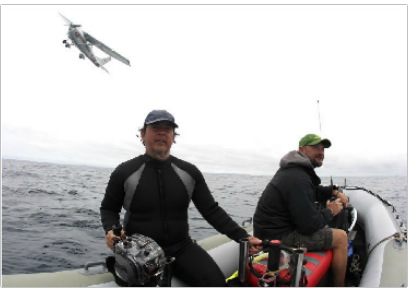|

Interview with Dr. Charles E. Rawlings.
Author of "Living Shells"
Charles Rawlings is a noted undersea photographer and a winner
in the San Francisco and New York Book Festivals. We caught up with him during
his hectic schedule to ask a few questions about the world underneath the
waves....
What was your introduction to the magic of sea shells? Was it on the beach as
a child, through a museum, or some other way?
RAWLINGS: My first encounter with a seashell was at the age of six, on
the beach, in Myrtle Beach, S.C. Following that my family always traveled to
Florida, Tampa/Clearwater actually during the summer. We stayed on the Bay in a
hotel with a breakwater. Every day I would walk the Bay side of the Breakwater
exploring and collecting dozens of different types of shells. � I then
progressed to shell stones and then museums. I have always been a collector�even
in kindergarten I put together a leaf collection, butterfly collection, etc.
Once hooked on shells I began collecting them � usually dead ones � difficulty
cleaning them with the smell precluded takes ones with animals.
The magic of shells to me has only progressed � I still get a thrill just
visiting even a small shell museum much less and instillation like the
Smithsonian.
What is it that fascinates you about shells?
RAWLINGS: Wow�the list is almost endless.
-
Size 1mm � 6 feet
-
Location � worldwide � collected in ice field on shores of
Hudson Bay to tropics in New Guinea.
-
Depth�1 inch to abyssal plains
-
Mathematical symmetry � Nautilus, spiral
-
Color
-
Shape
-
Animal
o Ability to construct such a shell
o Cone shells with poison
o Poison properties�entire scientific field
o 1/1000 millisecond for harpoon
o Nautilus � depths with no decompression
o Camouflage
o Self-preservation�dropping Tale
-
Amazing Beauty
Tell us how your career as a photographer began.
RAWLINGS: Underwater Photographer � 1st DAN and dive lessons.
-
Loved the underwater realm
-
Was diving for 2-3 years and noticed degradation/changes of
the reef
-
Artistic shapes, colors, and textures.
-
Started with underwater photography as means to capture that
loss and the art of the reef
-
Began Macro� especially abstracts
-
Large animals especially whales
-
Living seashells
-
Able to photograph many species of shells never before
photographed alive
What is your preferred equipment for your book�s photographs?
What�s the one piece of equipment you wish you had but don�t (even if it doesn�t
exist)?
RAWLINGS:
-
Nikon D-80 in Ikelite Housing
-
DS 125 strobe as main strobe
-
D5 51 slave strobe with light sensor/meter for fill in
-
60mm � 105 mm macro lenses
-
2 hypothetical pieces � perfect exposure strobe and lens
that allows close-up of animal plus environment.
What�s the most fun experience you�ve had while photographing
for the book?
RAWLINGS: Interacting with native villagers especially
children who collect then �help� by providing the shells � kids are always so
anxious that you appreciate what they find.
-
New Guinea: women
-
Philippines
o Tangle net fisherman.
o List and then they will try and find them
-
Nautilus trapping: from the prepping to those anxious
movements as the trap is pulled from 1500� water.
-
Submersible looking for slit shells
-
Working with my editor/publisher arranging the photos.
I know it�s like asking a father to name his favorite
child, but do you have a favorite photograph in your collection? Tell us how it
came about.
RAWLINGS: I can honestly say that I enjoyed each and every experience
associated with each photograph and remember each one. But the one that truly
stands out is when I was able to take the first photograph of a living guttata
cowrie� the great white spotted cor.
I was in the Philippines around Balicasag Island and had asked around amongst
the fisherman for a living one never expecting they could find one. Next morning
a solemn procession came to my boat with a live guttata. I immediately suited up
and photographed it on the wall. I was so excited I was shaking as the animal
emerged from the shell and gradually extended covering the shell and revealing
the animal in all its glory � all the while allowing me to photograph it as it
emerged.
Have you seen changes in the undersea �climate� during your
time? Wondering about the ecology of that world and if it is changing as rapidly
as our above-water climate seems to be transforming.
RAWLINGS: Honestly, yes but not in the way you may think.
What advice do you have for someone who aspires to take up
underwater photography? Any special training, equipment or knowledge needed?
RAWLINGS:
-
Be an amazing diver
-
Keep your day job
-
Be prepared for hassles in traveling
-
Equipment � be obsessive � what can go wrong, will go wrong!
-
Totally open-minded. Go with the flow.
-
Have fun
-
Think out of the box. Let your artistic mind free-flow so to
speak.
You mentioned you�re working on your next book. Tell us what
you can about it.
RAWLINGS: Actually 3 books.
|